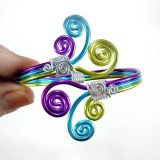What Are the Colors of Kimonos for Women?
The kimono is a traditional Japanese garment that has been worn for centuries. Kimonos come in various colors, with certain shades carrying more profound cultural significance. Women’s kimonos, in particular, utilize color in symbolic ways, with certain hues representing different virtues, seasons, ages, and marital status.
This in-depth guide will explore the engaging world of kimonos for women colors. From the standard colors on furisodes worn by unmarried women to the subdued tones of mourning garments, we will uncover the nuances of this aspect of Japanese culture.
So, join us on a journey through the vibrant chromatic language of the kimono. Let’s slip out of our plain modern clothes and into the beautiful hues of old Japan.
The Importance of Color in Kimono Culture

Before diving into the specific colors, it helps to understand why color is meaningful in kimono culture. Some key points:
- Kimonos are a canvas for self-expression. While the garment’s shape and structure are relatively fixed, choosing fabric patterns and colors allows wearers to convey individual styles and preferences.
- Colors represent virtues and values. Various hues are associated with positive qualities like youthfulness, elegance, or maturity. Wearing those colors expresses the cultivation of those virtues.
- The colors match the seasons. Lighter and more vibrant colors tend to appear in spring and summer kimono, while fall and winter bring more muted and darker shades.
- Colors indicate age and marital status. Younger, unmarried women wear bright colors with flashy patterns. Older married women dress in plain, modest colors.
So, the color of a woman’s kimono conveys layers of cultural meaning. It’s a code that reflects her age, virtues, mood, and time of year.
Standard Colors for Women’s Kimono
While the possible color combinations are endless, certain hues frequently appear on women’s kimonos. Some of the most prevalent include:
Pink
Various shades of pink—from pastel blossom colors to deep fuchsia—are beloved kimono colors for women. Pink represents youthfulness, health, happiness, and fun. It is considered an auspicious color.
Young women often wear pink furisode with splashy patterns to Coming of Age Day ceremonies. The pink kimono helps signify their youth and bright futures.
Red
A vibrant red kimono commands attention. Red is associated with confidence, passion, and sensuality. Brides often wear red uchikake kimono over their white wedding robes.
Red is also considered a protective color to ward off evil and hardship. It’s common to see red obi sashes paired with kimonos of other colors.
Green
Green symbolizes nature, health, youth, and renewal. It connotes life energy and vivacity. When vegetation flourishes, Green is a popular color for spring and summer kimonos.
Lighter pastel greens evoke the first tender buds of spring, while deeper emerald hues resemble the lush foliage of early summer. Green is a festive and cheerful kimono color.
Blue
While pink and red dominate for unmarried women, blue is a common choice for married women. Blue represents fidelity, trust, and stability—fitting qualities for a wife. Navy, indigo, and powder blue maturely complement the borrowed white wedding kimono.
Pale blue can also evoke girlishness for young unmarried women. Blue furisodes with abstract patterns are a playful option for Coming of Age Day.
Yellow
The cheerful hue of yellow conveys optimism, joy, and warmth. Certain shades of yellow are associated with royalty and nobility. Yellow is an auspicious color for babies and young children, based on connections to sunlight and new beginnings.
For women, light sunny yellows work for spring, and citrusy shades pair well with summer. Deeper goldenrod yellows suit the fall harvest season.
Purple
The color purple is linked with luxury, creativity, and spiritual wisdom. In the past, the dye for purple was rare and expensive, so only wealthy elites could afford it. Today, purple still conveys elegance and refinement.
Light lilac and lavender purples have a soft, romantic femininity. Vibrant violets and deep magentas make bold color statements.
Orange
Bold and bright orange kimonos symbolize happiness, positivity, and fun. Orange is energetic and eye-catching. It represents the warmth of autumn’s foliage and harvest.
For women, lighter peachy oranges work well in spring and summer as a lively alternative to pink. Deeper terra cotta shades shine in the fall.
Black
Solid black kimonos are pretty rare. But different styles incorporate black accents or understated black-and-white patterns. Black represents formality and solemnity.
It’s common to wear black obi sashes with formal woven crests during wedding ceremonies and funerals. Black conveys dignity and decorum when paired with a kimono in another color.
White
White kimonos symbolize purity, sacredness, and new beginnings. The bride wears a white kimono during Shinto wedding ceremonies. Mourners also wear white as a color of mourning.
White is rarely worn outside those contexts, as it could signify anti-socialness or isolation. But white accents and white-based patterns frequently supplement other colors.
White blossoms and red or orange add a playful spring vibe: bamboo stalks or snowy landscapes in black and white express winter.
Brown
Natural brown shades connect to the earth, wood, and soil. Browns represent stability, calmness, and resilience. Deep chocolate browns have a mature elegance.
Brown grounds have brighter colors when used for obi sashes or woven into patterns. It provides an earthy counterbalance to the main kimono’s pinks, oranges, or reds.
Seasonal Colors
Beyond specific hues, the colors of women’s kimonos strongly tie to the seasons. Lighter and brighter colors suit the liveliness of spring. Deeper, darker shades match the solemnity of winter. Observing these seasonal norms is an important cultural tradition.
Spring Colors
Spring kimonos for women utilize light, delicate colors that reflect nature’s blooming. Soft pinks, minty greens, sky blues, and buttery yellows capture the essence of blossoms opening and baby birds chirping. Pastels and cherry blossom hues are quintessential.
White represents the pure, blank canvas of a new cycle beginning. Combinations like pink and white or yellow and white evoke spring’s sense of fresh starts.
Summer Colors
As greenery thickens in summer, kimono colors become more prosperous and vibrant. Emerald greens, sunny yellows, clear blues, and passionate reds dominate summer kimono palettes.
Heavier silk fabrics may also incorporate purple, orange, turquoise, and indigo dye. Summer is a time for lively self-expression and color experimentation before the muted winter comes again.
Autumn Colors
Autumn brings a mature mellowing of colors. Deeper shades of red, purple, orange, gold, and brown reflect the turning leaves. Navy blue and forest green also connect to the coolness of autumn’s end.
Complex patterns may combine several colors with stylized images of autumn foliage, flowers, animals, or harvest scenes. It’s a season for intricate, blended color palettes.
Winter Colors
As snow covers the landscape, winter kimonos use starkly contrasting color schemes. Black and white patterns—like snowflakes, bare trees, or calligraphy—express winter’s stark essence. Dark browns, deep purples, greyish blues, and forest greens convey mature sophistication.
Obi sashes adopt black or burgundy hues rather than the bright spring colors. Winter kimono designs feel simpler, starker, and more formal. The season is not focused on lively displays.
Furisode: Kimonos for Unmarried Women
Let’s look at how color conventions apply to different kimono types. The most colorful style is the furisode, worn by unmarried women.
Furisode translates as “swinging sleeves.” These kimonos have floor-length sleeves that flutter dramatically. They’re made from opulent brocade silk in vibrant, youthful colors.
- Pink furisodes are most popular, followed by purple, blue, green, and orange shades. Yellow and red appear as well, but less commonly.
- Patterns feature large, splashy designs like flowers, vines, leaves, butterflies, abstract shapes, or seasonal images. These reflect a playful youthfulness.
- Obi sashes may be equally bright, or brown and black may be used to ground the look.
A woman wearing a furisode signals she’s of marriageable age and playfully seeking a husband. The bright colors attract positive attention during formal events.
Homongi: Everyday Casual Kimonos
Homongi translates as “visiting wear” and serves as casual everyday kimonos when not dressed formally. The colors tend to be muted, modest versions of furisode hues.
- Softer pinks, lavenders, greens, blues, yellows, and oranges are typical. Red appears occasionally.
- Smaller patterns with seasonal flowers, plants, or scenery maintain a casual femininity.
- Obi sashes may adopt the same fabric as the kimono or use simple blacks, browns, or whites.
The toned-down colors of homing kimonos work for women who are married, older, or don’t need to wear ostentatious furisode. It maintains elegance without going overboard.
Kurotomesode: Formal Kimonos for Married Women
Kurotomesode are formal black kimonos worn by married women. Kuro means “black,” and the timecode is a short black section along the bottom.
- The primary color is solid black or extremely dark grey. This conveys maturity and dignity.
- An elegant pattern appears along the bottom third in green, gold, purple, blue, or pink colors. Common motifs are flowers, leaves, fruit, or scenery.
- The obi sash is often a contrasting bright hue like red or orange. This livens up the sober black.
Kurotomesode kimonos help married women appear refined and sophisticated during important ceremonies and events. The black base color conveys her settled marital status.
Irotomesode: Formal Wedding Kimono
Irotomesode means “colored timecode.” Unlike kurotomesode, these have a bright, lively background color along with most kimonos.
- Red, gold, pink, purple, green, and blue backgrounds are familiar. Orange and yellow can also be seen.
- The bottom third trimming adopts a simple black, grey, or white pattern. Bamboo, flowers, or scroll motifs maintain formality.
- Obi sashes may coordinate or contrast with the primary color.
Brides will often wear irotomesode, then switch to a red uchikake kimono over it for the wedding reception. The colorful look conveys the joy of the occasion.
Mofuku: Plain White or Black Mourning Kimono
Mofuku means “mourning clothes.” It refers to plain white or black kimonos worn during mourning after a death.
- Solid white signifies the deceased’s spirit’s purity, light, and sacredness.
- Solid black conveys the somberness and void left in absence. It also wards off impurities.
- No patterns or accessories decorate Momofuku kimonos. They are stark and plain.
The mourning period dictates whether one wears a full white Momofuku or a total black Momofuku. These mute, simple colors demonstrate respect and reverence for the departed.
Colorful Kimono Sleeves for Married Women

A unique color exception for married women is in kimono sleeves. While their primary garment colors remain subdued, brighter sleeves offer a touch of vibrancy.
The contrast between muted body and colorful sleeves may represent:
- Happiness at being married but still retaining individuality
- Touch of youthfulness peeking through maturity
- Inner light concealed within outer modesty
This wedding of reserved and vibrant hues lets married women express themselves through color in subtle, classy ways.
Modern and Fashion Kimono Colors
While many still respect the traditional color conventions, modern kimono fashions also embrace bold new color schemes.
Some examples of creative color usage include:
- Vibrantly colored or patterned obi sashes combined with plain black kimonos
- Unnaturally bright pinks, greens, oranges, and purples
- Mixing traditional colors like red and green in unusual ways -656AED Solid black or white kimonos with colorful handpainted patterns.
- Fluorescent psychedelic colors and tie-dye patterns
Japan’s vibrant youth street culture pushes the boundaries through adventurous kimono modifications. Tradition and invention go hand-in-hand.
FAQs
Q: Why do young unmarried women wear such brightly colored furisode kimonos?
A: Vibrant colors and splashy patterns are seen as youthful and energetic. Wearing furisodes attracts positive attention during coming-of-age ceremonies or formal events where young women hope to find a potential husband. The bright colors advertise their availability and vivacity.
Q: How do the colors of women’s obi sashes affect the overall look?
A: Obi sashes help balance the kimono colors. A bright sash grounds a flashy furisode. Darker obis lend maturity to a young woman. Coordinating or contrasting obis support the wearer’s desired look.
Q: How do married women add lively colors to plain kimonos?
A: Their kimono body remains subdued, but the sleeves offer a pop of color. Also, married women get creative by combining colored linings with muted grey, black, or white external fabrics. An intricately brocaded obi can also inject color.
Q: What are some examples of seasonally symbolic colors and patterns?
A: Light pinks and whites with cherry blossoms say “spring.” Emerald greens and bright summer flowers signal late spring/early summer. Red leaves on navy backgrounds represent fall. Stark blacks and whites with snowflake or bamboo motifs depict winter.
Q: How do modern Japanese fashion designers play with traditional kimono colors?
A: Contemporary kimono fashions feature experimental hues like neon brights, clashing color blocks, ombre effects, and abstract handpainted patterns. Creativity blends with tradition. However, powerfully symbolic colors remain respected.
Conclusion: Colors Speak Volumes
The colors of kimonos for women form a rich visual language in Japanese culture. Although invisible to outsiders, for those steeped in kimono traditions, the colors convey a woman’s age, virtues, and current role. They tie into cultural values, annual cycles, and significant life events.
A Guide to Hawaiian Clothes for Women explores the vibrant spectrum of traditional and contemporary attire, much like how Japanese women, while respecting enduring customs, feel free to have fun with colorful self-expression, where the hues may shift from generation to generation, but kimonos remain a canvas celebrating beauty through color.
So, next time you see a flurry of elegant kimonos, take a moment to appreciate the nuanced meanings expressed in their palette. It tells a vivid, unspoken story.

















